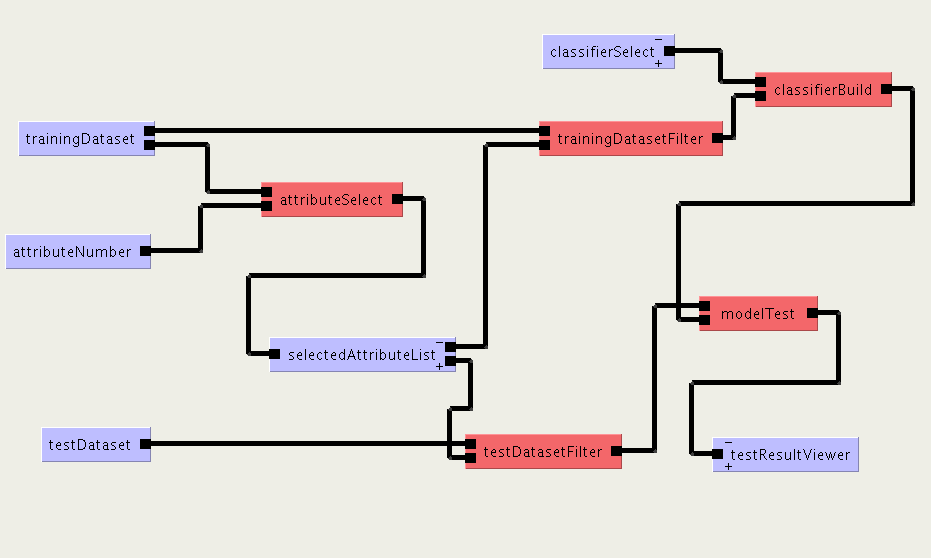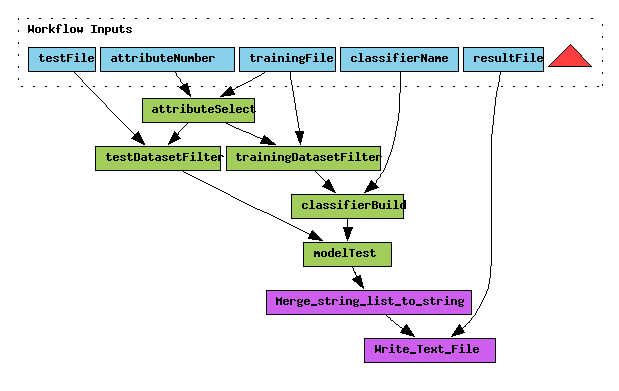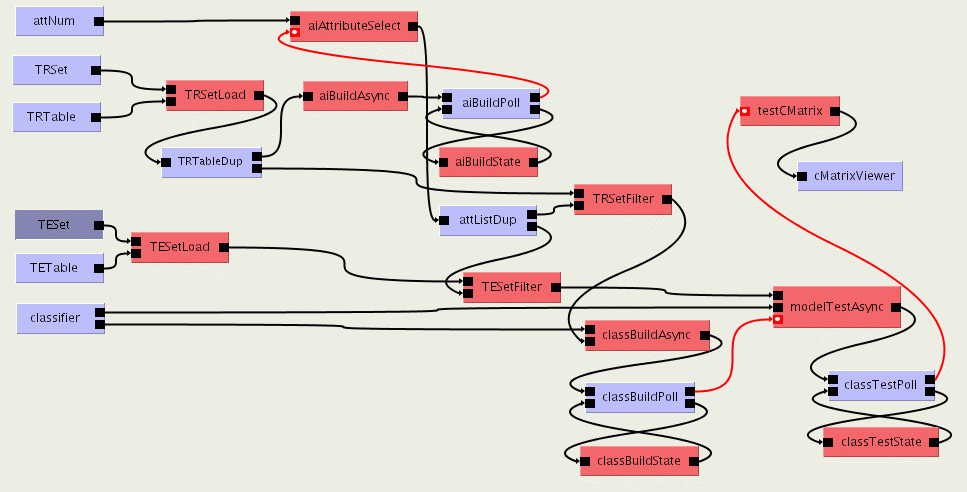Available test web services are
| OPERATION | INPUT | OUTPUT | DESCRIPTION |
| attributeRank | arffTrainingDataset (string): training dataset in arff format or URL pointing to it, last attribute is class label | attributeRankResponse (string): list of attributes with chi-square ranking values | Performs attribute ranking on arffTrainingDataset. Outputs the list of all attributes together with their chi-square ranking value. |
| attributeSelect | arffTrainingDataset (string):
training dataset in arff format or URL pointing to it, last attribute is class
label attributeNumber (string): max number of attributes to be selected |
attributeSelectResponse (string): comma separated list of selected attributes | Performs attribute selection on arffTrainingDataset. Outputs the list of most important attributes based on chi-square ranking. Max number of output attributes is specified by attributeNumber. |
| datasetFilter | arffDataset (string):
dataset in arff format or URL pointing to it, last attribute is class
label attributeList (string): comma separated list of attributes to be kept |
datasetFilterResponse (string): filtered dataset in arff format, all attributes not included in attributeList are removed | Filters arffDataset removing all attributes not included in attributeList. Outputs filtered dataset in arff format. |
| datasetDiscretize | arffDataset (string): dataset in arff format or URL pointing to it, last attribute is class label | datasetDiscretizeResponse (string): discretized dataset in arff format | Discretizes numeric attributes in arffDataset according to entropy discretization method proposed by Fayyad and Irani. Outputs discretized dataset in arff format. |
| classifierBuild | classifierName (string): weka classifier name
in dot notation (e.g. "weka.classifiers.lazy.IB1") arffTrainingDataset (string): training dataset in arff format or URL pointing to it, last attribute is class label |
classifierBuildResponse (string): hex encoded classifier | Builds classifier specified by classifierName, using arffTrainingDataset as training dataset. Outputs serialized classifier object (hex encoded). |
| clustererBuild | clustererName (string): weka clusterer name
in dot notation (e.g. "weka.clusterers.SimpleKMeans") arffTrainingDataset (string): training dataset in arff format or URL pointing to it, last attribute is class label |
clustererBuildResponse (string): hex encoded clusterer | Builds clusterer specified by clustererName, using arffTrainingDataset as training dataset. Outputs serialized clusterer object (hex encoded). |
| modelTest | arffTestDataset (string):
test dataset in arff format or URL pointing to it, last attribute is class
label encodedModel (string): hex encoded weka classifier or clusterer |
modelTestResponse (string): confusion matrix and other measures of model accuracy | Tests classifier or clusterer specified by encodedModel, using arffTestDataset as test dataset. Outputs confusion matrix and other measures of model accuracy. |
| modelApply | arffApplyDataset (string):
apply dataset in arff format or URL pointing to it, last attribute is class
label (class values are not important but must be
present) encodedModel (string): hex encoded weka classifier labelList (string): comma separated list of class values (labels) present in the training dataset in the same order |
modelApplyResponse (string): instance number, predicted class value and associated probability for each instance in arffApplyDataset | Applies classifier specified by encodedModel to arffApplyDataset instances. Outputs instance number, predicted class value and associated probability. |


| OPERATION | INPUT | OUTPUT | DESCRIPTION |
| datasetLoad | arffDataset (string):
dataset in arff format or URL pointing to it, last attribute is class
label datasetTable (string): name of Oracle ODM table containing the dataset |
aiDatasetLoadResponse (string): datasetTable (if load is successful) or error message | Loads arffDataset into Oracle ODM table datasetTable. |
| aiBuildAsync | datasetTable (string): name of the table in the Oracle ODM database containing the dataset | aiBuildAsyncResponse (string): name of Oracle task submitted for execution | Sets up the execution task to build an attribute importance model based on the dataset in table datasetTable. The task is submitted to the Oracle DBMS for asynchronous execution. Outputs the name of the Oracle task submitted for execution. NOTE: task execution should be monitored (taskState operation) until it has completed (successfully) before the model can be used. |
| aiAttributeRank | syncInput (string): any string on this input indicates that attribute importance model build task (operation aiBuildAsync) has completed execution | aiAttributeRankResponse (string): list of attributes with mdl ranking values | Uses the (most recently built) attribute importance model (operation aiBuildAsync) to perform attribute ranking. Outputs the list of all attributes together with their mdl ranking value. |
| aiAttributeSelect | attributeNumber (string): max number of
attributes to be selected syncInput (string): any string on this input indicates that attribute importance model build task (operation aiBuildAsync) has completed execution |
aiAttributeSelectResponse (string): comma separated list of selected attributes | Uses the (most recently built) attribute importance model (operation aiBuildAsync) to perform attribute selection. Outputs the list of most important attributes based on mdl ranking. Max number of output attributes is specified by attributeNumber. |
| datasetFilter | datasetTable (string):
name of Oracle ODM table containing the dataset attributeList (string): comma separated list of attributes to be kept |
datasetFilterResponse (string): name of Oracle ODM table containing the filtered dataset, all attributes not included in attributeList are removed | Filters dataset in Oracle ODM table datasetTable removing all attributes not included in attributeList. Outputs the name of Oracle ODM table containing filtered dataset. |
| classifierBuildAsync | classifierName (string): name of Oracle classifier
in dot notation (e.g. "classifier.abn") datasetTable (string): name of Oracle ODM table containing the training dataset |
classifierBuildAsyncResponse (string): name of Oracle task submitted for execution | Sets up the execution task to build classifier specified by classifierName, using training dataset in table datasetTable. The task is submitted to the Oracle DBMS for asynchronous execution. Outputs the name of the Oracle task submitted for execution. NOTE: task execution should be monitored (taskState operation) until it has completed (successfully) before the classifier can be used. |
| modelTestAsync | datasetTable (string):
name of Oracle ODM table containing the test
dataset classifierName (string): name of Oracle classifier in dot notation (e.g. "classifier.abn") syncInput (string): any string on this input indicates that classifier build task (operation classifierBuildAsync) has completed execution |
modelTestAsyncResponse (string): name of Oracle task submitted for execution | Sets up the execution task to test (most recently built) classifier specified by classifierName, using test dataset in table datasetTable. The task is submitted to the Oracle DBMS for asynchronous execution. Outputs the name of the Oracle task submitted for execution. NOTE: task execution should be monitored (taskState operation) until it has completed (successfully) before test results can be used. |
| testConfusionMatrix | syncInput (string): any string on this input indicates that test classifier task (operation modelTestAsync) has completed execution | testConfusionMatrixResponse (string): confusion matrix and other measures of model accuracy | Fetches the (most recent) test results (operation modelTestAsync). Outputs confusion matrix and other measures of model accuracy. |
| modelApplyAsync | datasetTable (string):
name of Oracle ODM table containing the apply
dataset classifierName (string): name of Oracle classifier in dot notation (e.g. "classifier.abn") syncInput (string): any string on this input indicates that classifier build task (operation classifierBuildAsync) has completed execution |
modelApplyAsyncResponse (string): name of Oracle task submitted for execution | Sets up the execution task to apply (most recently built) classifier specified by classifierName, to the apply dataset in table datasetTable. The task is submitted to the Oracle DBMS for asynchronous execution. Outputs the name of the Oracle task submitted for execution. NOTE: task execution should be monitored (taskState operation) until it has completed (successfully) before apply results can be used. |
| applyPrediction | syncInput (string): any string on this input indicates that apply classifier task (operation modelApplyAsync) has completed execution | applyPredictionResponse (string): instance number, predicted class value and associated probability for each instance in apply dataset | Fetches the (most recent) apply results (operation modelApplyAsync). Outputs instance number, predicted class value and associated probability. |
